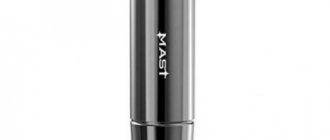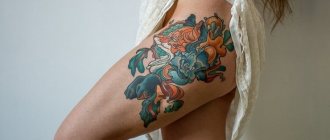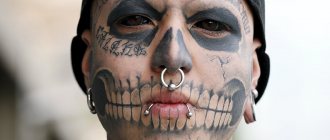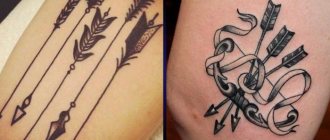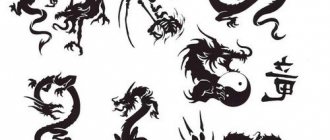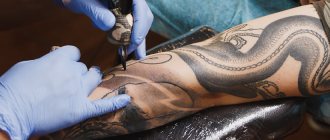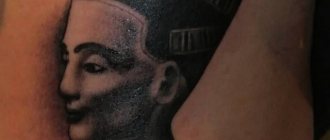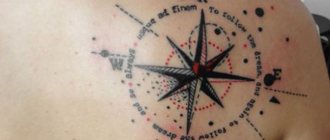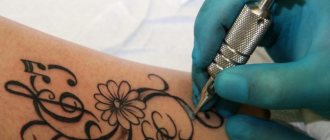Definition of the word "Tattoo" by the BSE:
Tattoo (French tatouer - to tattoo, from English. tattoo. source - Polynesian.) Drawings on the body by introducing under the skin dyeing substances. It is made by pricking with a wooden, bone (or metal) needle, which is struck with a hammer (some peoples of Oceania, Southeast Asia, Indians of North and South America), or by stitching the skin with a needle with a colored thread, which is then removed (the peoples of Northeast Asia). T. is associated with the ancient customs of the test of endurance in the initiation of young men into adult men, served as a sign of magical protection from evil spirits, etc. Т. It was not only an ornament, but also a sign of the tribe, clan, totem, and social affiliation. It was not only an ornament, but also a sign of a tribe, clan, totem, social affiliation, and so on. Widespread among people with fair skin (in dark-skinned people T. is replaced by scarring), especially in Polynesia, where it was performed by special masters, covering the whole body with drawings, even the tongue. The custom of T. was imported by sailors from Southeast Asia to Europe, where it survives as a decoration or commemorative mark. To remove the T. used mainly surgery, the method - excision of the relevant areas of the skin, followed by suturing or skin grafting. It is also possible to destroy T. with a "light knife" - a focused laser beam (see "The light knife"). Laser radiation), diathermocoagulation of pigmentation foci, using chemical substances (concentrated solutions of zinc chloride, tannin, trichloroacetic acid, etc.), causing tissue necrosis in the place of their application with the subsequent formation of a scar, or dermabrasion (grinding) of the skin with sandpaper, salt crystals, etc.
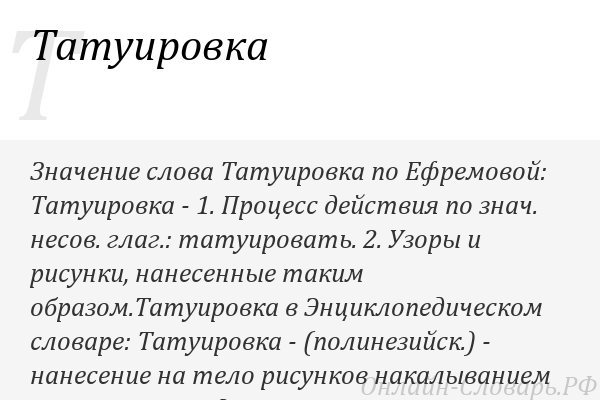
The difference between tattoos and tattoos
Having analyzed the concept of tattoos and tattoos, as well as their historical development, we can safely define their difference in several aspects.


- Linguistic. Nakolka is a word from prison jargon and was used in our country before the term "tattoo" appeared.
- Semantic. The word "nakolka" in modern society has acquired some negative meaning, and now it denotes drawings exclusively criminal orientation.
- The method of application. Nakolka - using homemade devices, often with disregard for sanitary conditions. Tattoo - in a specialized salon, by professionals in compliance with all requirements of hygiene.
- Meaning. The meaning of a tattoo is strictly limited to the prison realities of gangster life, while tattoos have a multifaceted meaning.
From the analysis above it is clear that tattoo and tattoo are not equivalent concepts, and to substitute one word with another is definitely not worth it.
Tattoo care
Proper tattoo care is very important, especially if we are talking about the first days after the drawing. We will present a number of mandatory recommendations that must be followed in order to avoid typical problems such as infection, damage to the integrity of the design and more:
- Take off the bandage after tattooing exactly as instructed by your master. This time is usually 4 to 12 hours, depending on the extent of your tattoo.
- For the first few days after applying the tattoo, wash it with warm water and soap without the use of alcohol-containing substances.
- After the first "home" washing, apply an antibacterial agent recommended by your master to the drawing area.
- Do not, under any circumstances, peel off the crust that has formed. Give the skin time to heal and the crust will eventually fall off on its own.
- In the first days after applying the tattoo, avoid direct sunlight. UV light can affect the appearance of the tattoo.
- It is better to refuse alcohol and other drugs that increase blood pressure at the stage of tattoo healing. Increased pressure can change the tattoo by knocking out the pigment.
- Try to avoid serious physical activity in the first weeks after getting a tattoo.
Remember that improper tattoo care can ruin the original appearance of the tattoo. Besides, getting an infection is not the most pleasant thing, so home care should be taken seriously. You do not want the fine work of the master to lose the brightness and clarity of the lines, do you?
"The pros and cons of getting a tattoo
What does your tattoo mean? Where do you want it tattooed? Will it be relevant in a few years? If you haven't answered these questions, you should definitely consider whether you're ready to decorate your body with a tattoo. To be objective, we'll present the arguments for and against tattoos.
Benefits of a tattoo:
- A tattoo is a great way to express yourself creatively;
- A tattoo looks sexy on both the male and female body;
- Tattoo is unconsciously associated with the freedom of the individual;
- Tattoo can become your personal talisman, which is always with you;
- Tattoos today have become a cultural trend and are at the peak of popularity.
Disadvantages of tattoos:
- Tattoos are painful, especially for people who are hypersensitive;
- Tattoo is considered by many to be asocial jewelry, which definitely does not go with a white collar and a business suit;
- Tattoo - it is conditionally forever.
We recommend that you choose your tattoo carefully so that you don't spend a lot of money on its removal. Think about what you expect from the picture and why you want to decorate his body.Only consciously made tattoo will not be for you a disappointment in the future.
Sincerely, the team portal KissMyTattoo.ru
Tattoo Styles
Of course, body art is an immense field for creativity. However, over the years of tattoo culture has been formed several key styles that are brightly different from each other and have their own characteristics. Here they are:
- Realism.
Its essence is the application of drawings with a detailed and realistic representation of people, animals, characters, landscapes, etc. Despite the stereotype that realism began to develop not so long ago, in fact such tattoos adorned noble bodies as early as the 19th century. Seeing a portrait of a commander on an officer's shoulder was a normal occurrence. - Oriental.
Already from the name it is clear that this style is intertwined with Eastern culture. Do you like tattoos depicting dragons and mythical fish? Are you attracted to the themes of geishas and Japanese samurai? Or would you like to decorate your body with a magnificent cherry tree? Then the Oriental style will suit your taste. - Chicano.
The style originated in the first half of the 20th century in the United States, when the crime syndicates were actively expanding their sphere of influence. At that time, the Chicano style tattoos could be seen on the muscular torsos of fearless mafiosi. Chicano is a very specific style that is popular in the criminal world as well as among the civilian population. - Biomechanics.
The essence of the style is an imitation of the mechanical construction of the human body, hidden under the skin. A torn muscle under which gears, pistons and bearings are hidden is a classic biomechanics style tattoo. - Oldschool.
Old school European and American tattooing dates back to the 19th century. The popularity of the style is now falling, then rising again. Unchanging fans of the genre are fans of heavy music and brutal lifestyles. A massive anchor on the chest or a hellish skull across the back. Would you like one? - Treble.
Perhaps the most popular tattoo format. The success of this genre is understandable - the tattoos are usually done in the same color and are clever abstract weaves of impetuous patterns . In form they can be very different, but in most cases have lines similar to flames, daggers and shuriken. Treble is a traditional tattoo format in Oceania as well as in some African tribes. Evidence also suggests that similar tattoos adorned the bodies of the Mayans. - Thrash.
The philosophy of this style is to see beauty even in the most terrible things. In this style, even a photo of such tattoos can evoke powerful emotions in a non-experienced public. - Dotwork.
A special technique of tattooing, which formed an authentic style. Dotwork allows you to create geometrically complex designs.In this case, the brightness and contrast of the details depends on the density of the dots on a particular area of the skin.Dotwork is a "dish" for the true gourmets of body art. - Polynesia.
Rich and unusual tattoos that have male and female variations. On the shoulders of guys and men look militant and aggressive, which adds to their charm. For women, such tattoos make them even more brutal and wild. - New School.
A new trend in body art that emerged in the 1980s. A new school of tattoos was popularized around the world. New-school is characterized by bright colors and non-trivial subjects. Often, with all this mixed psychedelic and abstract. - Traditional.
The traditional trend of body art has its own history and a special meaning. Do not take a superficial attitude to all these butterflies, scorpions and hearts. Symbolism and sacred meaning in these tattoos is especially bright. Behind the external minimalism hides the completeness of the composition and concise wisdom. - Blackwork.
This style is extremely authentic. It can be recognized by the large-scale areas of skin, literally flooded with black paint to the state of a glossy homogeneous surface. Typical blackwork is geometric shapes evenly drenched in black paint on all areas. A black square on the back is a common format for a blackwork tattoo. However, the fact that the tattoo is done in black does not mean that it belongs to the blackwork family. - Neo-traditional.
The style is slightly different from the traditional style. In many ways, it resembles the new-school. - Ethnics.
Relatively recently, ethnic trends have entered the trend. These tattoos are characterized by an amazing variety of designs, interesting color combinations and volumetric images. - Sketch Style.
Truly an authentic style that completely breaks the stereotype that the tattoo should be bright, clear and sophisticated. Sketch Style is more like a sketch in a moleskin, rather than a fine sketch. - Watercolor.
Even if you're skeptical about tattoo culture, the "watercolor" style can change your perception of body art. These tattoos are preferred by creative natures. Watercolor has nothing in common with other styles, which makes it a special direction in art. - Handpoke.
Such tattoos are characterized by simplicity of execution. As a rule, handpoke style tattoos look funny and often indecent.
Of course, the world of tattoos is not limited to the above styles. Masters of body art are constantly experimenting and creating new directions in this non-trivial art. In addition, much depends on the artist himself, because some masters practice their own style, incomparable to any of the existing ones.
Tattoos in the religions of the world
The world religions differently interpret such a cultural phenomenon as a tattoo. Consider the most interesting facts in this direction.
- Islam considers the application of a body drawing as a sin of the body. Perhaps that's why it's almost impossible to meet a fan of body art among the representatives of the Middle East.
- Christianity does not encourage body painting or cutting, as described in the Bible. Nevertheless, in Christianity the rejection of tattoos looks more like a kind admonition than a sinful act. Christianity considers tattoos to be an occult phenomenon because such drawings were popular among both pagans and dark cultures. In addition, the Christian religion perceives the human body as a temple of God, which is why both Orthodoxy and Catholicism treat tattoo culture with coolness.
- Buddhism neither permits nor prohibits tattoos. In other words, a person is free to choose how to dispose of his or her body. Nevertheless, Buddhism does not encourage the creation of attachments to one's outward image. If we consider the idea of getting a tattoo as a desire to affirm and declare one's authenticity, then in this respect Buddhism recommends abandoning such worldly attachments.

